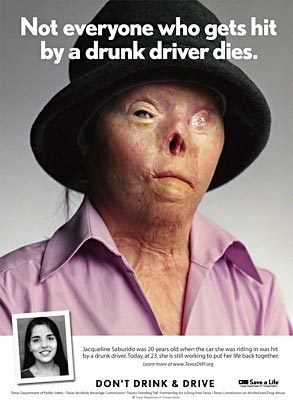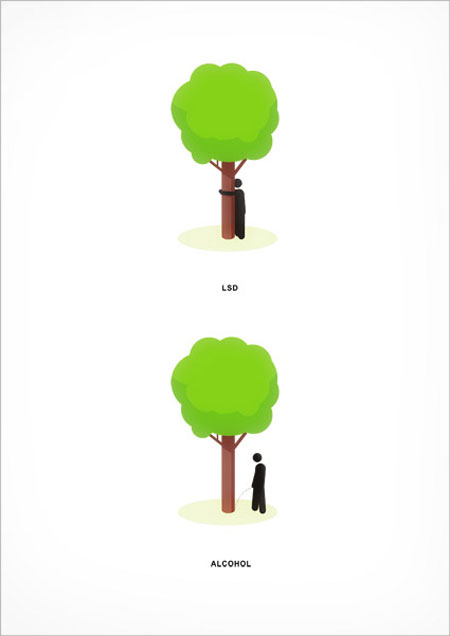It has often been said that a picture is worth a thousand words; if this statement is true all I would have to do to meet the requirements of this essay is post one and a half pictures on my blog (that should cover the1500 words). Jokes aside, it is undeniable that visual communication is becoming increasingly important in our society. We are bombarded with thousands of images on a daily basis and many of those images are meant to sway our opinion in one direction or another. This influence on our choices can be geared toward something as simple as the specific brand of chewing gum we buy, or something as important as who we elect as our next president. Persuasion as intended towards its audience has been divided into three general categories by Aristotle; ethos, pathos, and logos. All three forms of persuasion can be used effectively individually, but can be even more effective when used together.
When seeing a picture or a video for the first time, it is often quite easy to make out what impact the image is trying to make. It is even easier to be convinced by the image when its message is consistent with our personal beliefs. For example, when the average person sees a poster of an underprivileged, starving child in a third world country, their reaction is one of empathy and compassion. This feeling of empathy is often followed a resolution to donate money or other resources to a charity aiding those in need. The emotion and action is consistent with the generally human instinct to help others in need. However sometimes the message conveyed by the image is not easily taken by the perceiver. One subject in particular that this can apply to is consuming alcohol. We have been through assembly after assembly in high school and even several in college with the same message being pounded into our brains; “Alcohol at first can be consumed leisurely, but if is not controlled carefully, it can become dangerous quickly.” We may understand the severity of this subject, but sometimes it gets disregarded as we have heard it over and over again. Having a couple of drinks in rarely considered as being dangerous, and can even be considered instrumental to good times. This softened view towards drinking is largely due to images that portray drinking as fun, exiting, and at times are portrayed as a sign of status.

This image is the most striking of all the images shown. It shows a young girl who has had horrible damage done to her face as the result of a drunk driving accident. This picture also uses pathos to express the potential dangers of drinking. It can rely almost completely on only one type of persuasion because the impact of it so powerful. The emotional response by anyone viewing this image would usually be rather strong and sudden. On a personal note when I first viewed this photo, one of the things that struck me was the left eye. It seems to be judging the viewer in almost a grim contempt. It would definitely make me think twice about drinking and driving. The small picture in the left hand corner is also adds an effective touch to the image. By showing how the girl was prior to the accident it makes the image of her after the accident all the more gruesome and devastating. The differing images of the girl are enough to prove the point that drinking and driving can have terrible consequences, but the combination with the caption makes it particularly potent. The line reads, “Not everyone who gets hit by a drunk driver dies.” In an ironic way this line makes the accident seem as upsetting or possibly even more than if the girl had died from the accident. There is an immeasurable pain in what the girl what will be forced to endure because of this mindless act.

The image above shows an endorsement of a well known celebrity endorsing a particular brand of vodka. By using P. Diddy, Puff Daddy, Diddy, Sean Jean, or whatever his chosen name is this week, the marketers hope to increase the popularity of Ciroc Vodka. There are two types of persuasive appeal used in this image. Ethos is used by showing a respected (at least by some) figure as a user of the product, possibly also by way of indicating that individual has extensive experience in the subject of drinking so perhaps one should trust his judgment in regards to this alcoholic product. Pathos is also used effectively in the same image. There is an air of sophistication in the picture and it creates the festive mood of a party which would sway its viewers to be placed in a similar mindset. Some people claim that the reason that they drink is to “escape” the everyday hassles and pressures of life. This picture reaffirms that sense of escaping the everyday tedium. It appeals to one’s emotions by sending the message that no party would be complete without this drink. (or P. Diddy for that matter)

The next image is that of a person who is a respectable citizen by day, and an indecent (even if more amusing) citizen after a few drinks. Even though the picture is a humorous one it still makes a strong and clear point. It makes use of logos by appealing to logic to illustrate the impact alcohol can have on one’s demeanor. This is one case that can be made about alcohol and its effects. So many fail to realize and accept the impact it can have on them and their resulting actions can be unfortunate, as shown in the picture. The humor in and of itself can be considered pathos, as humor can be a very persuasive tool in swaying someone’s emotions. It actually seems wise to convey the effects of alcohol in an alternative way as opposed to a traditionally upsetting image. We have constantly been hit with devastating images of the effects of drinking but this different approach breaks up the monotony and increases the chances that we might actually consider the message. This picture also makes use of humor to prove that drinking has more of an impact on you than you might think. Instead of this video using ethos to convey the message, it used its lack of ethos to convey the message. It is not credible but it is true to the fact that that impaired judgment is definitely a progression and one can see that after one or two drinks the judgment is not too impaired, but after several, things can become dangerous in more ways than one.
All of these images prove the point that alcohol consumption has many views and can be approached in many different ways. Since all these images come to varying conclusions, it is difficult for the consumer or viewer to form a solid judgment on how to approach it as well. The best conclusion that one can come to is that drinking like all things in adult life is about personal judgment. It is necessary to beware of the images that suggest that there are no consequences of alcohol consumption. No matter how many times we see the images of the abusive alcoholic or the arrested family man caught drinking and driving, we have to remember that even in the images are monotonous the message is not. Alcohol can impair one’s mental abilities whether it affects their ability to play in the championship beer pong match or impact something as serious as the life of another human being. This is only one of thousands, even millions, of subjects that visual images and videos influence our opinions on, on a daily basis. We cannot help but subconsciously be swayed by this visual bombardment, but it is important to try our best to step back and question whether we are being swayed in the direction that is consistent with what we believe to be the right thing, at least when it really counts.

